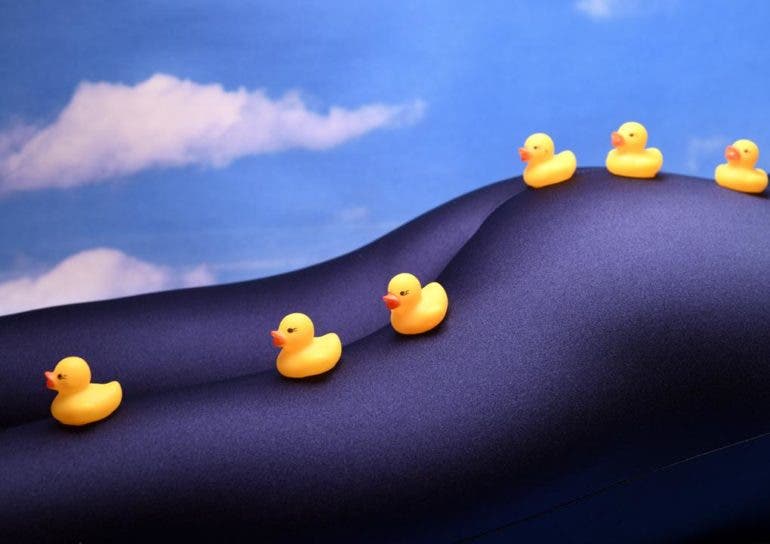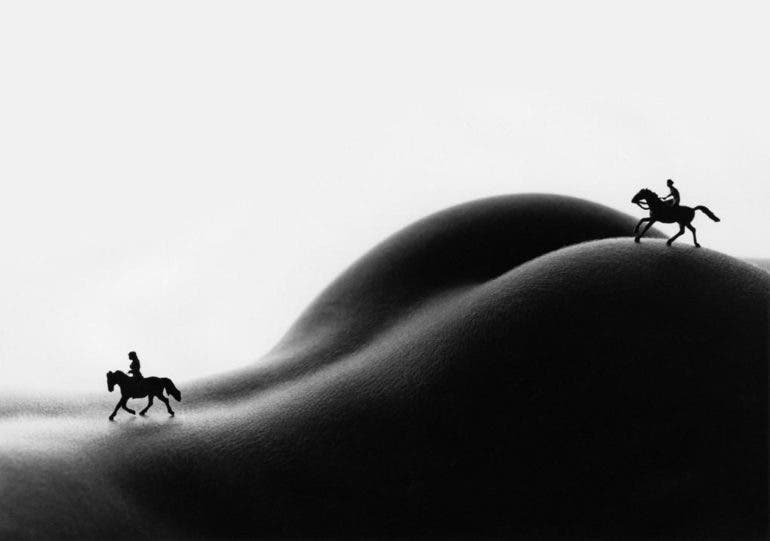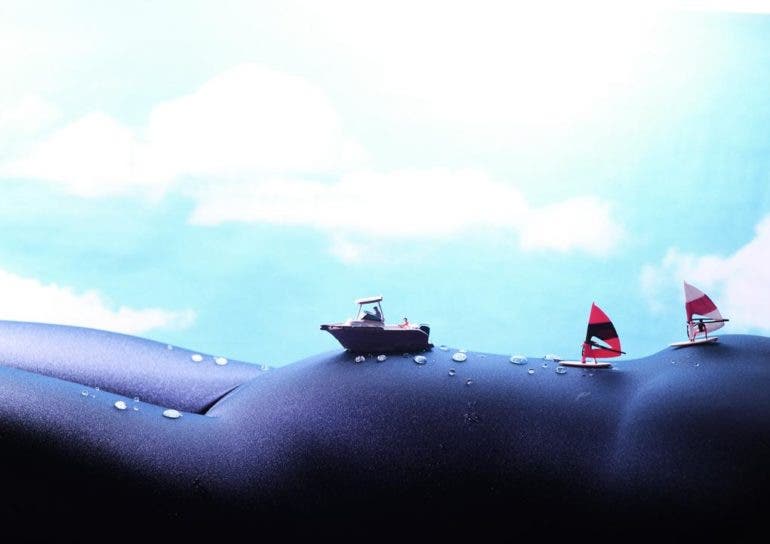Allan Teger Combines Nudity and Still Life for His Majestic Photos (NSFW)
All images by Allan Teger. Used with permission.
“They see what happens in our mind as we experience a shift in perspective,” explains Allan Teger as he discusses the impact his photos have on his viewers. He adds, “that is the most important part of my work.” His photographs certainly do make you question what you’re seeing. Combining humanity with still life, Teger has amassed a body of work that removes itself from the status quo. Our readers know we love work that goes against the norm. And it felt nothing but natural to invite Teger to speak with us to talk about a series that’s lasted over 45 years.
Phoblographer: When you first pitched the BODYSCAPES concept to a model, what was the reaction?

Allan Teger: When I first got the idea of shooting photos of small toys on a nude body, in 1976, I had no samples to show anyone. I tried to explain what I was planning, but it was difficult to convey the images that I had in mind. A friend connected me with a friend of his, and she agreed to model. Her only requirement was that we begin by shooting something that didn’t require her to take her clothes off, and we start with something where she could see what I was doing. “Fair enough,” I said.
The first shoot was with a miniature lady, sitting on her fingertip. The second was of mountain climbers on her nose, and finally fishing in the navel. All of which required no removal of clothes. The first shoot went well!
Phoblographer: Your background is in psychology. How has that influenced the way you approach your art?

Allan Teger: My Bodyscapes came directly out of my background in psychology. I was teaching courses in the psychology of consciousness, meditation, and eastern philosophy.
I was especially influenced by the books by Carlos Castenada, where an anthropologist became the apprentice of a native sorcerer – or shaman – in Mexico. He was taught to move between two different realities – our normal reality and a higher consciousness – where the rules of reality were different. I wanted to show through art that there could be multiple realities existing together.
One way to do that would be to show that two different interpretations could exist simultaneously. I thought about this for many months. I had set up my old model railroad for my children, and among the pieces were some very small HO scale skiers, about 3/4 inch tall. It occurred to me that I could place these small skiers on a woman’s breast, and I could create the illusion of a real ski slope. That was it – I knew at once that I had an entire body of work waiting for me to explore.
Phoblographer: At what stage of the work did you realize it wouldn’t be just a short term gig but rather a career-long body of work?

Allan Teger: It didn’t occur to me that this would be my life’s work, but it was immediately obvious that many images would unfold in this project! It was exciting. I felt that I had found a way to make my statement, and I had found something new!
Phoblographer: Any new project creates an initial buzz and infatuation within the photographer. Fast forward to the present time, how strong is your buzz for Bodyscapes today?

Allan Teger: After two books, hundreds of images, and many sales, publications and awards, I still enjoy the Bodyscape project. Some of the new work involves reshooting and improving old images. Sometimes I have a new idea for a group of images, such as the zodiac series. I use two models together, and the bodySTOCKINGscapes where the model wears a body stocking and I shoot in color.
I have plans for several other new variations of the Bodyscape theme. I feel that this body of work is unique and that I have developed a very distinctive style that can continue to expand. The quest to produce art that enables the viewer to expand their consciousness is still a driving force in my work. However, there are times when I do need to express something, but it doesn’t really work in the Bodyscape format. For that, I have a new body of work, ‘metaphors’, shown here. This work is more surreal and mystical and can be more focused on content as the viewer doesn’t get distracted by a body. I direct this work to collectors and galleries.
Phoblographer: Most nude photography tends to focus on the person. But I feel in your photographs it’s the miniatures that take center stage. Was that your intention, and if yes, why?

Allan Teger: I also realized that the idea of creating the illusion of landscape by means of miniatures on the nude body, would dovetail nicely with a number of aspects of psychology. The project had echoes of the old gestalt psychology illustrations, where an image of an old lady, for example, could also be seen as a young girl. The reversal of the images was also a play on ‘figure-ground reversal” where the object and the background changed places.
Here, the figure (the body) became the “ground.” Most important to me was that the viewer could experience a shift in perception – as the landscape suddenly became a body in their mind. This sudden shift was the most important thing about the work, because I wanted the viewer to experience a change in their perceptions or consciousness – to experience the letting go of one interpretation in favor of a different one.
This has been my guiding thought throughout the years. My work has never been about nudes. I never set out to find a new approach to nudes. It has always been, instead, to find a device that permitted the viewer to experience a shift – where they said “wait a minute”! – this was the goal.

Some people say that the Bodyscapes are funny – but humor wasn’t my goal either. I did realize, however, that Freud had said that humor was when you suddenly found that you had something in the wrong category – like when after the punchline, you “get” a joke. Bodyscapes fit that perfectly, although humor wasn’t my goal. Although most people relate to my work in terms of humor, or eroticism, there are people who get what I am really trying to do. They see that it is what happens in our head as we experience a shift in perspective. That is the most important part of my work.
Having been a professor of psychology, I was accustomed to communicating something to people. I have always felt that art should be more than just our own personal expression. If it is real art, it would of course, have to start that way. But if we want to communicate with the viewer, it is also useful to take into consideration how to best facilitate such communication.
Phoblographer: You offer custom shoots. It’s not your usual shoot for people who want photos of themselves. What tends to be the common motivation for people to work with you?
Allan Teger: Wherever I show my work I have people volunteering to be models. Some of them want to validate themselves as attractive people. Often they only want to do it once, so that they can say, when they are older, that “when I was young, I was a nude model.” Some are interested in the art and want to be part of the project. Some like the work, but say that they would not want to hang a nude on their wall unless it was a nude of themselves, so they volunteer for a shoot!
Phoblographer: Talk to us about your tools. Camera, lighting, props: what do you like to use to execute your creative vision?
Allan Teger: When I began, I used 35mm film and a Nikormat camera. My first set-up was very simple. The model lay on the floor. Behind her was a tripod with a clamp-on utility light attached to the tripod handle. The light aimed down on a mat board, which leaned against the tripod’s legs. I lay on the ground at a right angle to the model, with the camera braced in my hands and my elbows on the floor.

After a few years, that set-up was replaced with a medium format Mamiya RB67 which I used for many years. Now the lights were on stands, the model on a table, and the camera was on the tripod. About seven or eight years ago, I switched to digital capture and now use a Nikon D850. My lights are Lowell quartz lights. I feel that I can better evaluate the lighting effects with full hot lights rather than strobes. I use HO scale model railroad figures whenever I can. They are usually very detailed and just the right scale. I also use dollhouse props, toys, Christmas ornaments and collector miniatures.
Phoblographer: The work has been published all over. Exhibitions, prints, magazines, artwork: can you share with us some of your proudest moments?

Allan Teger: I began showing and selling the Bodyscapes at art festivals and galleries while I was still teaching psychology at the University of Pennsylvania and then Boston University. I would teach during the week and then on weekends, and throughout the summer, I would travel to art festivals around the country. I realized at some point that I would have to choose one career or the other, as both were becoming full-time jobs!
As the psychology of consciousness and spirituality were not well accepted in the academic world at that time, it felt that the art world was more supportive of who I was and what I was trying to express. I left academics in 1981 to pursue art full time. With the advent of the internet, I find that my work is reaching around the world, and I am able to make connections easily through my website. I have had some incredible experiences: Playboy Video did a show on me, as did a German tv show.

I have been interviewed many times and have had over 30 one-person shows in cities like Las Vegas, Chicago, Boston, Sarasota, Philadelphia, etc. My work is in magazines in over 25 countries. I find that I am often selling to the children of my original customers – people who say that they grew up with my photos in their family home, and now they are getting them for their own home!
Phoblographer: Having done this project for decades, creatively speaking, what keeps you inspired today?

Allan Teger: The fact that the work makes people smile is very important to me. I find it very rewarding to share fun and beauty with others. When I talk with customers at an art festival, its often like a party in my booth. People are laughing, joking, and end up talking with each other as well. They are excited about the new work, and often offer suggestions about new Bodyscape ideas.
Phoblographer: Overall, how do you feel about your body of work?

Allan Teger: I feel good about the work. But I know that some of the ideas I have in my head will produce even better work in the future. I look back at where I was 45 years ago – I couldn’t even imagine how the work would develop. The future is still exciting!
You can see more of Allan’s work by visiting his Bodyscapes website and his Teger website.